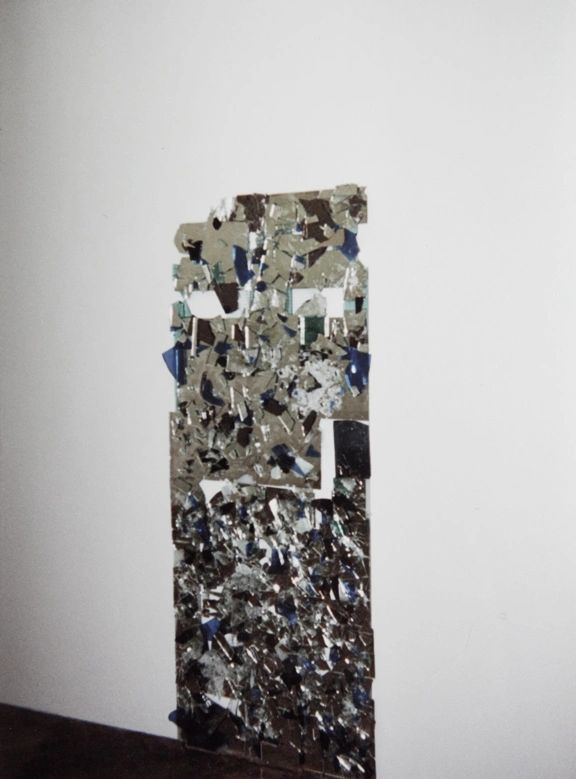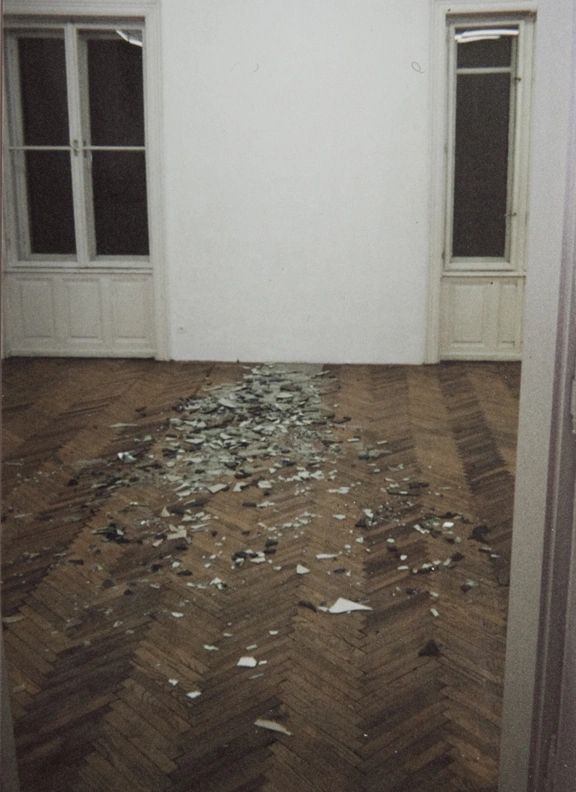Installation view at Galerie Grita Insam
Vienna, Austria
1997
Performance/Installation coincides with lecture presented at Universitat fur Angewandte Kunst in Vienna on The (Re-)Constructed Mirror.
The exhibition included the making of a 2.5 meter mirror "painting"
which consisted of hundreds of found and reclaimed shards of
mirror, that were then painted on the back with fluorescent paint,
and glued onto a thin wooden armature that hung against the wall.
After repeating the lecture at the gallery (a version of this is at the
bottom of this page), the work was (without warning) allowed to
fall from the wall, and immediately after the gallery lights were turned off, revealing the back of the glowing shards in the darkness. This was an attempt to dramatize the philosophical "center" of the work itself, that is to say, that beauty is still a recoverable value in our world, but that it must be re-constructed from the shards of historical meaning in a continual process of breaking and remaking.

Installation View Untitled (Mirror#2)
Galerie Grita Insam
Vienna
Mirror shards with fluorescent paint
@ 2.8 M x 1.5m
1997

Detail

Detail

Detail

Detail

Detail

Detail
Partial Text from Notes on a (Re-)Constructed Mirror
Presented in Vienna, Austria November, 1997
As a teenager growing up in the late
Sixties, in suburban America, I had, like teenagers have always had,
certain ways of speaking. I'm thinking specifically of certain words
we used that while authentic at the time, have since become codified,
and clichéd as stale emblems of that generation. Far out, psychedelic,
cool, and even wow (uttered reverentially) stood in for the
experience of being impressed, amazed,… (or simply stoned). In retrospect,
though quaint by today's standard I think this vocabulary also exemplified
a way of thinking (and seeing) that I miss, and still desire. We put
up aluminum foil on our bedroom walls, hung our black light posters,
plugged in the lava lamps, and cranked up the Hendrix. Looking back,
I am convinced that, although unknowingly, those light shows, posters,
and lava lamps recall a moment when the concept of the sublime
was perhaps most alive as a living thing at work in our culture. Unconsciously,
and supremely unaware we were paying tribute to ideas that Malevich
or Mondrian would have understood. The transformative power of visual
symbols aligned with a redemptive Philosophy of the Utopian Ideal.
There is currently a good deal of critical
interest surrounding the meanings and importance of those artifacts
and signifiers that seemed to swirl around that peculiar cultural moment,
which occurred some thirty years ago. While I am not interested in the
redeployment of any signs associated with that time, I am still asking
myself questions about how a way of looking at the world that was both
intensely idealistic and oddly naïve, intensely retinal, and coolly
conceptual could be re-imagined.
Peter Hopkins
Vienna
1997